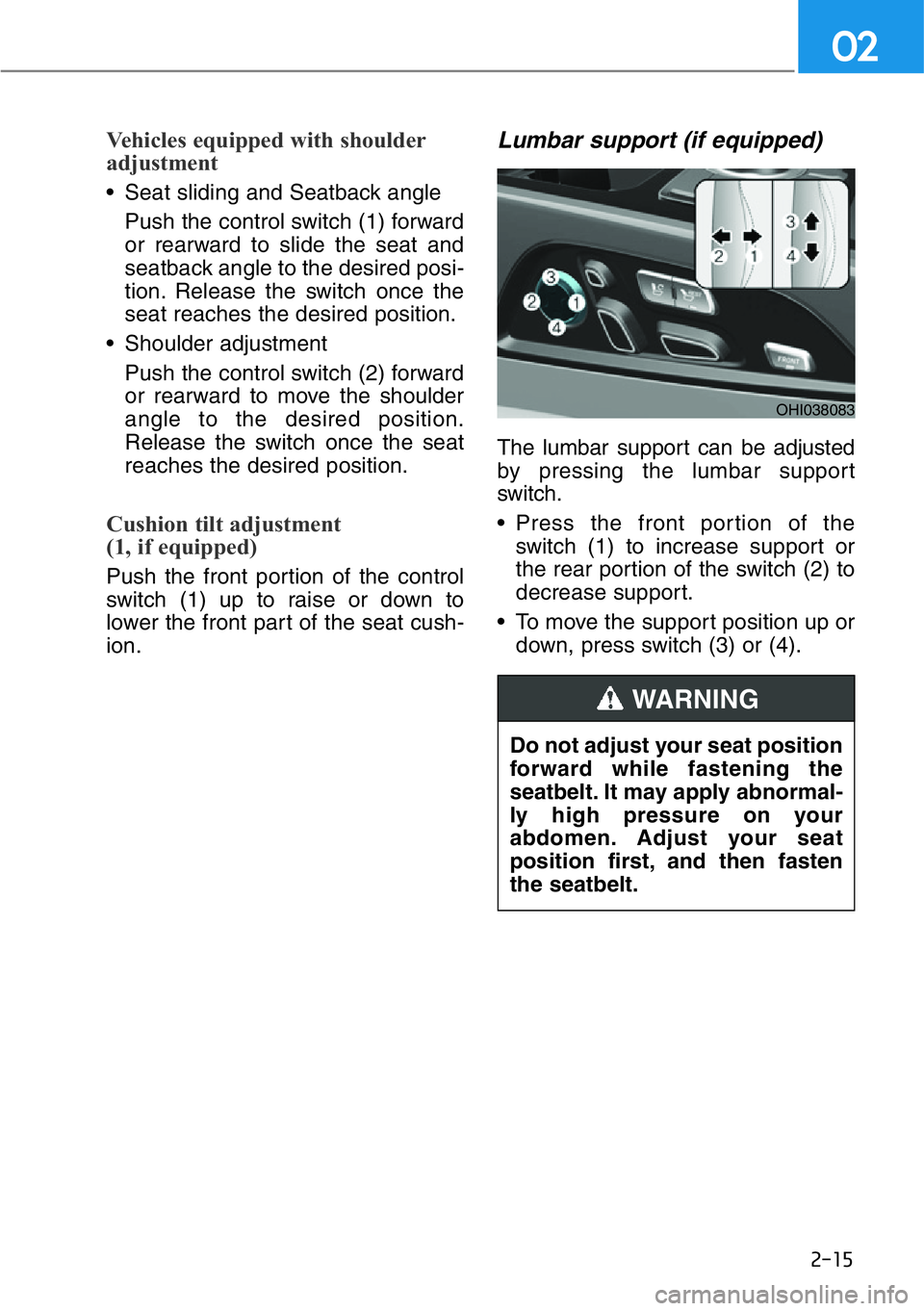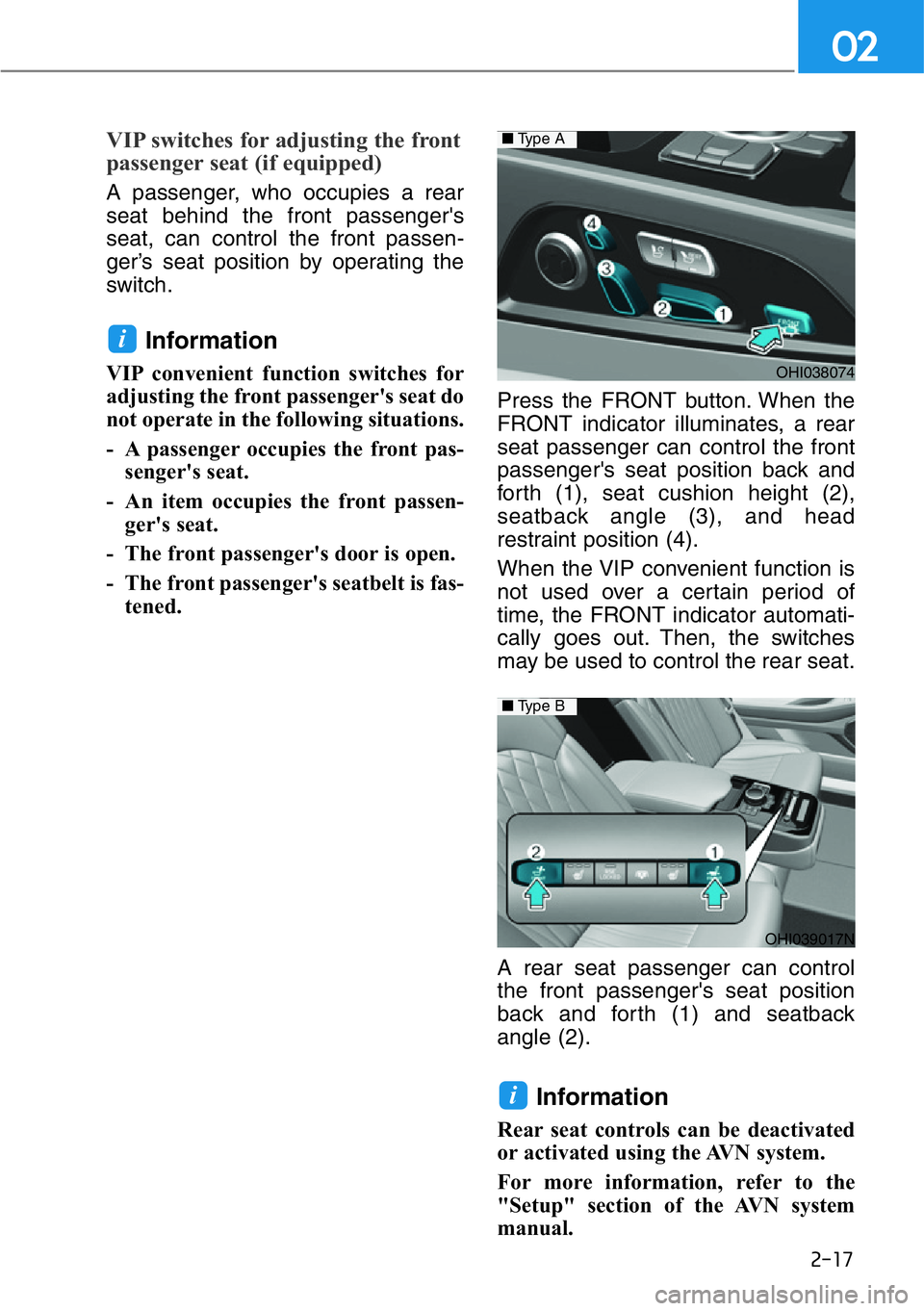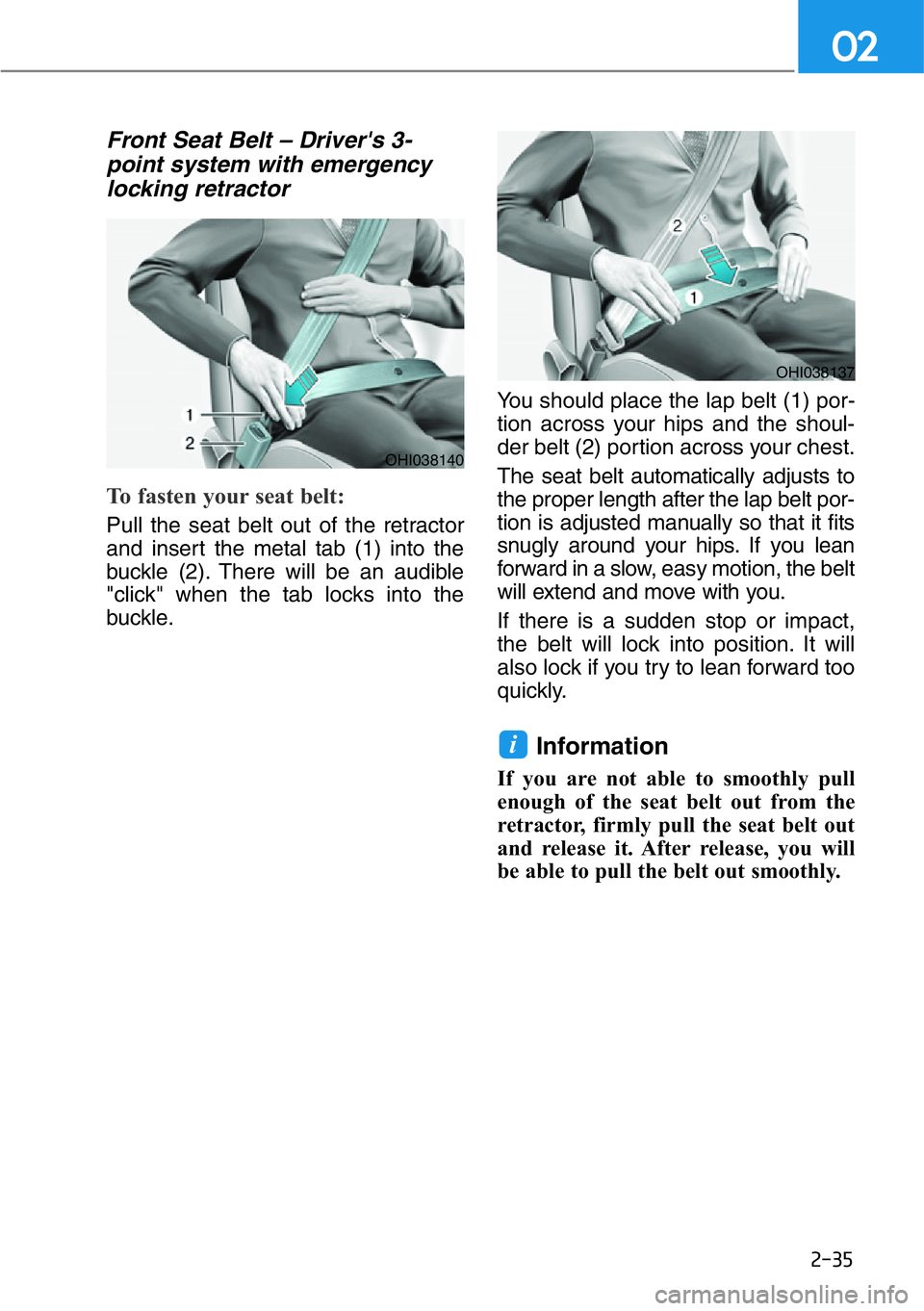2017 HYUNDAI GENESIS G90 belt
[x] Cancel search: beltPage 35 of 538

2-15
02
Vehicles equipped with shoulder
adjustment
• Seat sliding and Seatback angle
Push the control switch (1) forward
or rearward to slide the seat and
seatback angle to the desired posi-
tion. Release the switch once the
seat reaches the desired position.
• Shoulder adjustment
Push the control switch (2) forward
or rearward to move the shoulder
angle to the desired position.
Release the switch once the seat
reaches the desired position.
Cushion tilt adjustment
(1, if equipped)
Push the front portion of the control
switch (1) up to raise or down to
lower the front part of the seat cush-
ion.
Lumbar support (if equipped)
The lumbar support can be adjusted
by pressing the lumbar support
switch.
• Press the front portion of the
switch (1) to increase support or
the rear portion of the switch (2) to
decrease support.
• To move the support position up or
down, press switch (3) or (4).
Do not adjust your seat position
forward while fastening the
seatbelt. It may apply abnormal-
ly high pressure on your
abdomen. Adjust your seat
position first, and then fasten
the seatbelt.
WARNING
OHI038083
Page 37 of 538

2-17
02
VIP switches for adjusting the front
passenger seat (if equipped)
A passenger, who occupies a rear
seat behind the front passenger's
seat, can control the front passen-
ger’s seat position by operating the
switch.
Information
VIP convenient function switches for
adjusting the front passenger's seat do
not operate in the following situations.
- A passenger occupies the front pas-
senger's seat.
- An item occupies the front passen-
ger's seat.
- The front passenger's door is open.
- The front passenger's seatbelt is fas-
tened. Press the FRONT button. When the
FRONT indicator illuminates, a rear
seat passenger can control the front
passenger's seat position back and
forth (1), seat cushion height (2),
seatback angle (3), and head
restraint position (4).
When the VIP convenient function is
not used over a certain period of
time, the FRONT indicator automati-
cally goes out. Then, the switches
may be used to control the rear seat.
A rear seat passenger can control
the front passenger's seat position
back and forth (1) and seatback
angle (2).
Information
Rear seat controls can be deactivated
or activated using the AVN system.
For more information, refer to the
"Setup" section of the AVN system
manual.
i
i
OHI038074
OHI039017N
■Type B
■Type A
Page 38 of 538

2-18
Safety system of your vehicle
VIP seat mode switches
(if equipped)
Relaxation mode
Press the switch (1) to adjust both
the front passenger's seat and the
rear seat, as follows.
• Front passenger's seat
1. The seat position is adjusted for-
ward, the seatback is leaned for-
ward, and the head restraint is
lowered.
2. The head restraint is moved
rearward, and the seat cushion
tilt is lowered.
3.The seat cushion height is low-
ered.
• Rear seat
1. The seatback (including the
shoulder portion) is leaned back,
the head restraint is moved rear-
ward, and the head restraint is
lowered.
2. The seat position is adjusted for-
ward, the seat cushion tilt is
raised and the lower lumbar sup-
port is increased.
Information
Relaxation mode switches for adjust-
ing the front passenger's seat do not
operate in the following situations.
- When the Engine Start/Stop button
is in the OFF position.
- A passenger occupies the front pas-
senger's seat.
- An item occupies the front passen-
ger's seat.
- The front passenger's door is open.
- The front passenger's seatbelt is fas-
tened.
• Do not re-press the relaxation
mode switch again, while oper-
ating the seat positions for
relaxation mode. It may abruptly
stop the seat movement.
• When you operate the seat con-
trol switch while adjusting the
seat positions for the relaxation
mode, it stops the automatic
seat position adjustment. In this
case, manually adjust the seat
positions.
• Any items, which occupy the
front passenger's seat, may get
damaged while automatically
adjusting the seat positions for
the relaxation mode. Do not put
any items on the front passen-
ger's seat.
NOTICE
i
OHI038081
Page 39 of 538

2-19
02
Return function
Press the switch (2) to adjust both
the front passenger's seat and the
rear seat, as follows.
• Rear seat
1. The seat position is adjusted to
the rearmost position, the seat
cushion tilt is adjusted to the
lowest position, and the lumbar
support is decreased.
2. The head restraint is lowered,
and the seatback (including the
shoulder portion) is leaned
backward.
• Front passenger's seat
1. The seat position is adjusted
rearward, and the seatback is
leaned back.
2. The seat cushion height is
raised, and the head restraint is
adjusted to the lowest height.
Information
Return function switch for adjusting
the front passenger's seat do not oper-
ate in the following situations.
- When Engine Start/Stop button is in
the OFF position.
- A passenger occupies the front pas-
senger's seat.
- An item occupies the front passen-
ger's seat.
- The front passenger's door is open.
- The front passenger's seatbelt is fas-
tened. • Do not re-press return function
switch again, while operating
the seat positions for relaxation
mode. It may abruptly stop the
seat movement.
• When you operate the control
switch while adjusting the seat
positions with return function
switch, it stops the automatic
seat position adjustment. In this
case, manually adjust the seat
positions.
NOTICE
i
Page 52 of 538

2-32
Safety system of your vehicle
This section describes how to use
the seat belts properly. It also
describes some of the things not to
do when using seat belts.
Seat Belt Safety Precautions
Always fasten your seat belt and
make sure all passengers have fas-
tened their seat belts before starting
any trip. Air bags are designed to
supplement the seat belt as an addi-
tional safety device, but they are not
a substitute. Most states require all
occupants of a vehicle to wear seat
belts.
SEAT BELTS
Seat belts must be used by ALL
passengers whenever the vehi-
cle is moving. Take the following
precautions when adjusting
and wearing seat belts:
• ALWAYS properly restrain
children under age 13 in the
rear seats.
• NEVER allow children to ride
in the front passenger seat. If
a child age 13 or older must
be seated in the front seat,
move the seat as far back as
possible and properly restrain
them in the seat.
• NEVER allow an infant or
child to be carried on an occu-
pant's lap.
• NEVER ride with the seatback
reclined when the vehicle is
moving.
WARNING
• Do not allow children to share
a seat or seat belt.
• Do not wear the shoulder belt
under your arm or behind
your back.
• Always wear both the shoul-
der portion and lap portion of
the lap/shoulder belt.
• Do not use the seat belt if it is
twisted. A twisted seat belt
will not protect you properly
in an accident.
• Do not use a seat belt if the
webbing or hardware is dam-
aged.
• Do not latch the seat belt into
the buckles of other seats.
• NEVER unfasten the seat belt
while driving. This may cause
loss of vehicle control result-
ing in an accident.
• Make sure there is nothing in
the buckle interfering with the
seat belt latch mechanism.
This may prevent the seat belt
from fastening securely.
• No modifications or additions
should be made by the user
which will either prevent the
seat belt adjusting devices
from operating to remove
slack, or prevent the seat belt
assembly from being adjusted
to remove slack.
Page 53 of 538

2-33
02
Seat Belt Warning Light
Seat belt warning
Driver's seat belt warning
As a reminder to the driver, the seat
belt warning light will illuminate for
approximately 6 seconds each time
the Engine Start/Stop button is in the
ON or START position regardless of
belt fastening. At this time, if the seat
belt is not fastened a warning chime
will sound for 6 seconds.
If you continue not to fasten the seat
belt and you drive over 6 mph
(9 km/h), the warning light will stay
illuminated.
If you continue not to fasten the seat
belt and you drive over 12 mph
(20 km/h) the seat belt warning
chime will sound for approximately
100 seconds and the corresponding
warning light will blink.
If you unfasten the seat belt while
driving under 12 mph (20 km/h), the
seat belt warning light will illuminate
until the seat belt is fastened.
If you unfasten the seat belt while
driving over 12 mph (20 km/h), the
seat belt warning chime will sound
for approximately 100 seconds and
the corresponding warning light will
blink. Damaged seat belts and seat
belt assemblies will not operate
properly. Always replace:
• Frayed, contaminated, or
damaged webbing
• Damaged hardware
• The entire seat belt assembly
after it has been worn in an
accident, even if damage to
webbing or assembly is not
apparent
WARNING
OHI038167
Page 54 of 538

2-34
Safety system of your vehicle
Front passenger's seat belt warning
As a reminder to the front passenger,
the front passenger’s seat belt warn-
ing lights will illuminate for approxi-
mately 6 seconds each time the
Engine Start/Stop button is in the ON
or START position regardless of belt
fastening.
If you continue not to fasten the seat
belt and you drive over 6 mph
(9 km/h), the warning light will stay
illuminated.
If you continue not to fasten the seat
belt and you drive over 12 mph
(20 km/h) the seat belt warning chime
will sound for approximately 100 sec-
onds and the corresponding warning
light will blink.
If you unfasten the seat belt while
driving under 12 mph (20 km/h) the
seat belt warning light will illuminate
until the seat belt is fastened.
If you unfasten the seat belt while
driving over 12 mph (20 km/h), the
seat belt warning chime will sound for
approximately 100 seconds and the
corresponding warning light will blink.
Seat Belt Restraint System
Improperly positioned seat
belts may increase the risk of
serious injury in an accident.
Take the following precautions
when adjusting the seat belt:
• Position the lap portion of the
seat belt as low as possible
across your hips, not on your
waist, so that it fits snugly.
• Position one arm under the
shoulder belt and the other
over the belt, as shown in the
illustration.
• Always position the shoulder
belt anchor into the locked
position at the appropriate
height.
• Never position the shoulder
belt across your neck or face.
WARNING
OHI038139
Page 55 of 538

2-35
02
Front Seat Belt – Driver's 3-
point system with emergency
locking retractor
To fasten your seat belt:
Pull the seat belt out of the retractor
and insert the metal tab (1) into the
buckle (2). There will be an audible
"click" when the tab locks into the
buckle.You should place the lap belt (1) por-
tion across your hips and the shoul-
der belt (2) portion across your chest.
The seat belt automatically adjusts to
the proper length after the lap belt por-
tion is adjusted manually so that it fits
snugly around your hips. If you lean
forward in a slow, easy motion, the belt
will extend and move with you.
If there is a sudden stop or impact,
the belt will lock into position. It will
also lock if you try to lean forward too
quickly.
Information
If you are not able to smoothly pull
enough of the seat belt out from the
retractor, firmly pull the seat belt out
and release it. After release, you will
be able to pull the belt out smoothly.
i
OHI038140
OHI038137